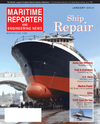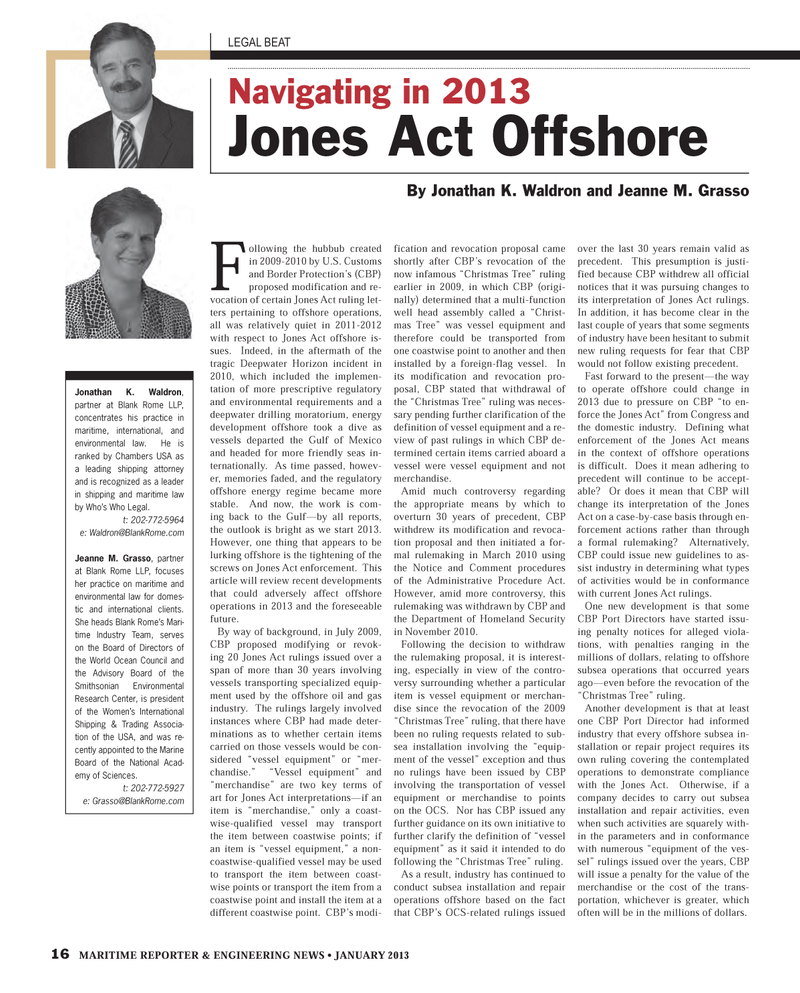
Page 16: of Maritime Reporter Magazine (January 2013)
Ship Repair & Conversion
Read this page in Pdf, Flash or Html5 edition of January 2013 Maritime Reporter Magazine
16 MARITIME REPORTER & ENGINEERING NEWS ? JANUARY 2013 Following the hubbub created in 2009-2010 by U.S. Customs and Border Protection?s (CBP) proposed modification and re-vocation of certain Jones Act ruling let- ters pertaining to offshore operations, all was relatively quiet in 2011-2012 with respect to Jones Act offshore is- sues. Indeed, in the aftermath of the tragic Deepwater Horizon incident in 2010, which included the implemen-tation of more prescriptive regulatory and environmental requirements and a deepwater drilling moratorium, energy development offshore took a dive as vessels departed the Gulf of Mexico and headed for more friendly seas in-ternationally. As time passed, howev- er, memories faded, and the regulatory offshore energy regime became more stable. And now, the work is com- ing back to the Gulf?by all reports, the outlook is bright as we start 2013. However, one thing that appears to be lurking offshore is the tightening of the screws on Jones Act enforcement. This article will review recent developments that could adversely affect offshore operations in 2013 and the foreseeable future.By way of background, in July 2009, CBP proposed modifying or revok- ing 20 Jones Act rulings issued over a span of more than 30 years involving vessels transporting specialized equip-ment used by the offshore oil and gas industry. The rulings largely involved instances where CBP had made deter- minations as to whether certain items carried on those vessels would be con-sidered ?vessel equipment? or ?mer- chandise.? ?Vessel equipment? and ?merchandise? are two key terms of art for Jones Act interpretations?if an item is ?merchandise,? only a coast-wise-qualified vessel may transport the item between coastwise points; if an item is ?vessel equipment,? a non-coastwise-qualified vessel may be used to transport the item between coast-wise points or transport the item from a coastwise point and install the item at a different coastwise point. CBP?s modi- fication and revocation proposal came shortly after CBP?s revocation of the now infamous ?Christmas Tree? ruling earlier in 2009, in which CBP (origi- nally) determined that a multi-function well head assembly called a ?Christ-mas Tree? was vessel equipment and therefore could be transported from one coastwise point to another and then installed by a foreign-flag vessel. In its modification and revocation pro-posal, CBP stated that withdrawal of the ?Christmas Tree? ruling was neces- sary pending further clarification of the definition of vessel equipment and a re-view of past rulings in which CBP de- termined certain items carried aboard a vessel were vessel equipment and not merchandise. Amid much controversy regarding the appropriate means by which to overturn 30 years of precedent, CBP withdrew its modification and revoca-tion proposal and then initiated a for- mal rulemaking in March 2010 using the Notice and Comment procedures of the Administrative Procedure Act. However, amid more controversy, this rulemaking was withdrawn by CBP and the Department of Homeland Security in November 2010. Following the decision to withdraw the rulemaking proposal, it is interest-ing, especially in view of the contro-versy surrounding whether a particular item is vessel equipment or merchan-dise since the revocation of the 2009 ?Christmas Tree? ruling, that there have been no ruling requests related to sub-sea installation involving the ?equip-ment of the vessel? exception and thus no rulings have been issued by CBP involving the transportation of vessel equipment or merchandise to points on the OCS. Nor has CBP issued any further guidance on its own initiative to further clarify the definition of ?vessel equipment? as it said it intended to do following the ?Christmas Tree? ruling. As a result, industry has continued to conduct subsea installation and repair operations offshore based on the fact that CBP?s OCS-related rulings issued over the last 30 years remain valid as precedent. This presumption is justi- fied because CBP withdrew all official notices that it was pursuing changes to its interpretation of Jones Act rulings. In addition, it has become clear in the last couple of years that some segments of industry have been hesitant to submit new ruling requests for fear that CBP would not follow existing precedent.Fast forward to the present?the way to operate offshore could change in 2013 due to pressure on CBP ?to en- force the Jones Act? from Congress and the domestic industry. Defining what enforcement of the Jones Act means in the context of offshore operations is difficult. Does it mean adhering to precedent will continue to be accept-able? Or does it mean that CBP will change its interpretation of the Jones Act on a case-by-case basis through en-forcement actions rather than through a formal rulemaking? Alternatively, CBP could issue new guidelines to as- sist industry in determining what types of activities would be in conformance with current Jones Act rulings. One new development is that some CBP Port Directors have started issu- ing penalty notices for alleged viola-tions, with penalties ranging in the millions of dollars, relating to offshore subsea operations that occurred years ago?even before the revocation of the ?Christmas Tree? ruling. Another development is that at least one CBP Port Director had informed industry that every offshore subsea in- stallation or repair project requires its own ruling covering the contemplated operations to demonstrate compliance with the Jones Act. Otherwise, if a company decides to carry out subsea installation and repair activities, even when such activities are squarely with-in the parameters and in conformance with numerous ?equipment of the ves-sel? rulings issued over the years, CBP will issue a penalty for the value of the merchandise or the cost of the trans-portation, whichever is greater, which often will be in the millions of dollars.LEGAL BEAT Navigating in 2013 Jones Act Offshore By Jonathan K. Waldron and Jeanne M. Grasso Jonathan K. Waldron , partner at Blank Rome LLP, concentrates his practice in maritime, international, and environmental law. He is ranked by Chambers USA as a leading shipping attorney and is recognized as a leader in shipping and maritime law by Who?s Who Legal. t: 202-772-5964e: [email protected] Jeanne M. Grasso, partner at Blank Rome LLP, focuses her practice on maritime and environmental law for domes- tic and international clients. She heads Blank Rome?s Mari- time Industry Team, serves on the Board of Directors of the World Ocean Council and the Advisory Board of the Smithsonian Environmental Research Center, is president of the Women?s International Shipping & Trading Associa- tion of the USA, and was re- cently appointed to the Marine Board of the National Acad- emy of Sciences. t: 202-772-5927e: [email protected] #1 (10-17).indd 16MR #1 (10-17).indd 161/2/2013 10:15:17 AM1/2/2013 10:15:17 AM

 15
15

 17
17
